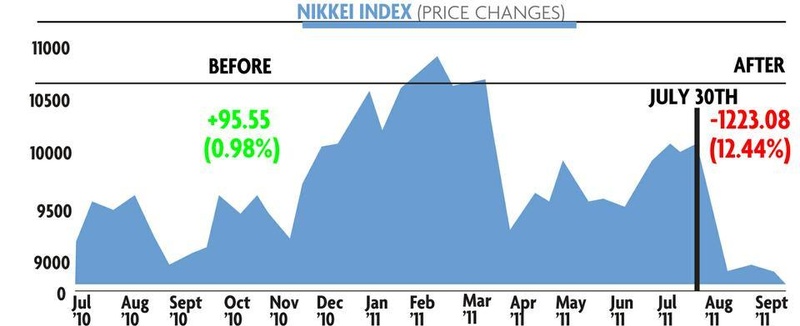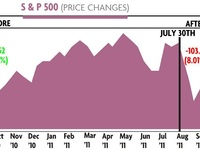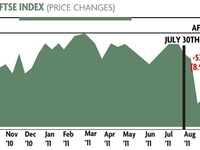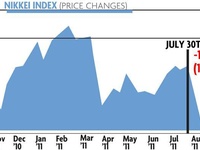Harvard’s endowment returns of 21.4 percent in fiscal year 2011, announced last week, beat benchmarks and were the highest in recent memory. But since the close of the fiscal year on June 30, the markets have shown extreme volatility, with some indices moving 4 percent daily.
While analysts applauded the recent returns of the Harvard Management Company, which manages the University endowment, the portfolio’s significant holdings in public equities expose it to these market swings.
Harvard’s gains in the past year represent the first major step in recovering losses that resulted from the 2008 financial crisis, when the endowment’s value plunged by nearly 30 percent, from $36.9 billion to $26 billion.
Since then, HMC has been reestablishing the value of the endowment—which yielded an 11.4 percent return in the 2010 fiscal year. It has done so while adopting a more conservative risk management structure to weather volatile markets. Analysts agree that the current year will begin to test the new risk structure as HMC fights to regain its pre-crisis endowment value.
THE FUTURE
Harvard has not said how it has performed since the end of June. After the close of the fiscal year, a number of factors caused concern for the broader financial community.
In August, the Standard & Poors rating agency downgraded U.S. Treasury debt from AAA to AA+ and further gave it a “negative outlook.”
At the same time, uncertainty about Europe’s fiscal future has increased, with investors questioning the abilities of Greece, Italy, and Spain to pay back their sovereign debt bills.
Even though HMC has actively reworked its positions in certain asset classes and specific securities to reduce risk—even hiring a chief risk officer in 2009 to help with the restructuring—Harvard will still be affected by these large fluctuations. “We are not immune to those impacts,” HMC President and CEO Jane L. Mendillo said in an interview last week.
Risk management is crucial, said Mebane T. Faber, a fund manager at Cambria Investment Management Inc. and co-author of “The Ivy Portfolio: How to Invest Like the Top Endowments and Avoid Bear Markets.”
HMC currently has about 12 percent of its portfolio invested in foreign equities. While that asset class is considered an area of great opportunity, volatility in Europe has threatened its performance in the months since Harvard’s fiscal year ended. And U.S. markets have also seen extreme swings in recent weeks.
But the financial problems in Europe may deal a relatively softer blow to Harvard due to the endowment’s low-risk stance, according to Cathleen M. Rittereiser, co-author of the book “Foundation and Endowment Investing,”
Because Harvard’s portfolio is designed to limit volatility compared to many for-profit funds, HMC’s investments might have fared better over the last few months than the S&P 500 Index, which has dropped 10.9 percent since June, she said.
Because of the efforts to reduce volatility, “in tougher years, the endowment should do better than the S&P,” said Lawrence E. Golub ’80, who runs Golub Capital, a private equity and venture capital firm.
“A lot of the pain that Europe is suffering is already priced into the financial markets,” Golub said. “I hope they only have limited exposure to the sovereign debt of risky European countries.”
Rittereiser also noted that the sovereign debt difficulties of a nation may not be reflected in the fiscal health of companies within that country. But if half of Europe’s banks need to be rescued, every investor will suffer, Golub said.
THE PAST YEAR
Although HMC’s gains on the year once again put the endowment in the vicinity of its $36.9 billion peak, Harvard underperformed the S&P 500 stock index. Analysts, however, say the endowment should be judged by a different standard.
Because HMC’s portfolio is diversified far beyond U.S. equities, which the S&P tracks, its results will naturally be different from the index, Rittereiser said.
“It is not an appropriate benchmark,” said Rittereiser of the S&P 500. “It is kind of like comparing apples to oranges.”
HMC sets its own policy portfolio benchmark, a custom metric that Rittereiser said is the best way to measure endowment performance because it reflect’s HMC’s unique risk appetite.
“I would be willing to say that it is highly likely that the risk-adjusted returns [of HMC] would be better than the S&P,” she said.
Every one of HMC’s asset classes outperformed its policy portfolio benchmark, except for private and public equities. Historically, private equity has been an enormously successful investment for the University.
Harvard and other universities were among the earliest investors in private equity, though the asset class has not performed as well in recent years due to greater competition in the industry.
Though many of Harvard’s closest peers have yet to release their endowment reports for 2011, it appears so far that Harvard has achieved above average returns. The University of Pennsylvania posted an 18.6 percent return for the last year, while Cornell’s endowment rose 17.2 percent.
But Stanford’s endowment, which released results earlier this week, rose 22.4 percent, a full percentage better than Harvard.
But like Mendillo, Stanford’s investment chief sees a bumpy road ahead.
“We remain concerned about the uncertain macroeconomic climate and its impact on global financial markets,” said John F. Powers, CEO of the Stanford Management Company, in a press release.
While Harvard appears ahead of the pack, Golub warns that the University cannot expect such exceptionally high returns on a regular basis.
“If you told me an endowment manager made 21 percent or more every year, I would say you’ve found Bernie Madoff,” Golub said.
Still, many remain confident that HMC will be able to weather upcoming financial storms.
“[Mendillo] is doing an outstanding job of building confidence in the alumni community that HMC is being a successful and responsible steward,” Golub said.
—Staff writer Gautam S. Kumar can be reached at gkumar@college.harvard.edu.
—Staff writer Zoe A. Y. Weinberg can be reached at zoe.weinberg@college.edu
Read more in News
Henderson, Melton Named University Professors
















